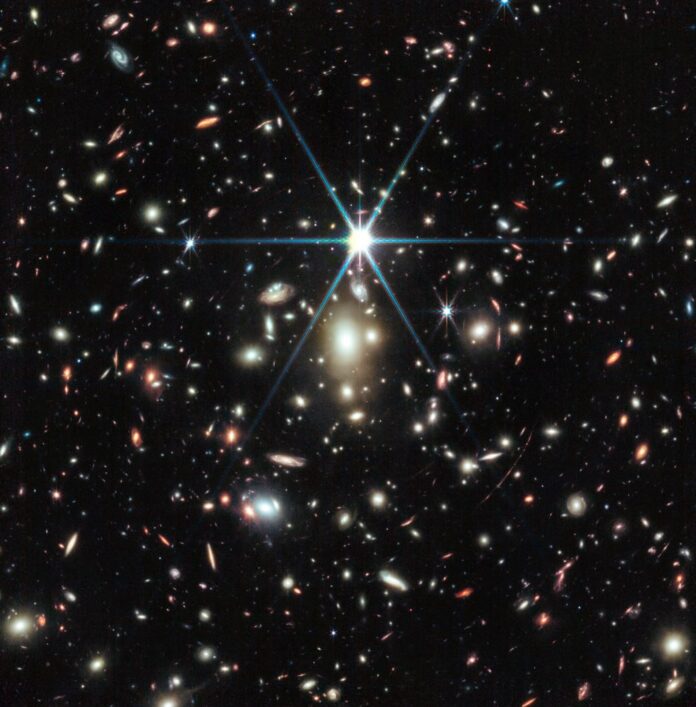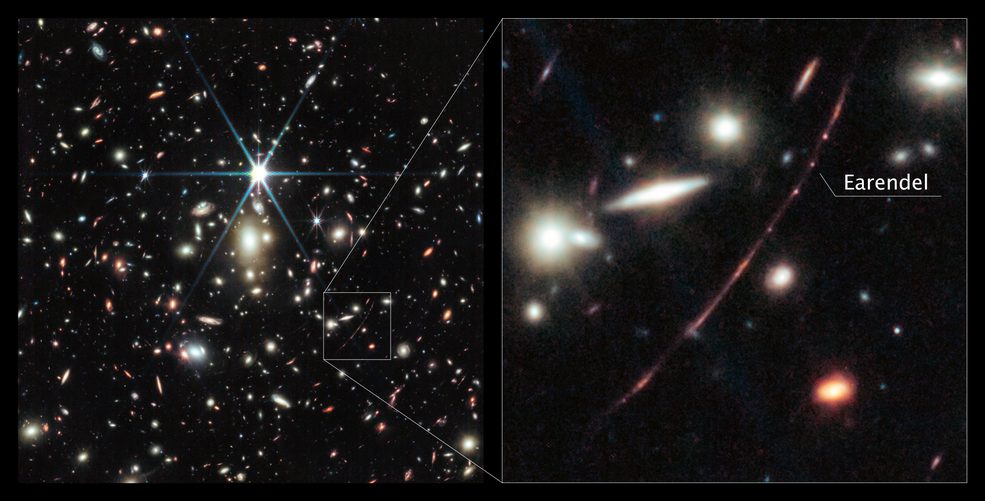
The James Webb Space Telescope has continued the Hubble observations of the most distant star ever discovered. It is located in a very distant Universe that emerged within the first billion years after the Big Bang.
Webb’s NIRCam (Near Infrared Camera) instrument shows that this star is a massive B-type star, more than twice as hot as our Sun and about a million times brighter.
Time record holder
The star, which the research team named Earendel, is located in the Sunrise Arc galaxy and can only be detected through the combined power of human technology and gravitational lensing. Both Hubble and Webb were able to detect Earendel due to the extreme magnification produced by the massive galaxy cluster WHL0137-08. The cluster of galaxies located between us and Earendel is so massive that it bends the very fabric of space, creating a magnification effect. This allows astronomers to look through the cluster as if through a magnifying glass.
While other objects in the galaxy appear multiple times due to gravitational lensing, Earendel appears as just a single point of light, even in Webb’s high-resolution infrared image. Based on this, astronomers have determined that the object is magnified at least 4000 times, and therefore it is extremely small. It is the most distant star ever discovered, with an age of 1 billion years after the Big Bang.
The previous record holder was discovered by Hubble and was observed about 4 billion years after the Big Bang. Another research team, with the help of Webb, recently identified a star with gravitational lenses, which they named Quillur, a red giant star observed 3 billion years after the Big Bang.
Planets and companions
Massive stars like Earendel often have companions. Astronomers didn’t expect Webb to detect any satellites of Earendel because they would be so close together and indistinguishable in the sky. However, based solely on Earendel’s colors, astronomers believe they are seeing hints of a colder, redder companion star. This light has been stretched by the expansion of the universe to a wavelength longer than Hubble’s instruments can detect, and so it could only be detected with Webb.

Credits: Image: NASA, ESA, CSA, D. Coe (STScI/AURA for ESA; Johns Hopkins University), B. Welch (NASA’s Goddard Space Flight Center; University of Maryland, College Park). Image processing: Z. Levay.
Sunrise arc
Webb’s NIRCam also reveals other notable details in the Sunrise Arc, which is the most magnified galaxy to be discovered in the first billion years of the universe’s existence. Features include both young star-forming regions and older star clusters up to 10 light-years in size. On either side of the maximum magnification wrinkle that runs right through Earendel, these features are reflected by the distortion of the gravitational lens.
The area where stars form appears to be elongated, with an estimated age of less than 5 million years. The smaller dots on either side of Earendel are two images of the same older, more established star cluster, estimated to be at least 10 million years old. Astronomers have determined that this star cluster is gravitationally bound and is likely to remain in existence to the present day.
Currently, astronomers are analyzing data from the Webb NIRSpec (Near-Infrared Spectrograph) observations of the Sunrise Arc galaxy and Earendel star, which will provide accurate measurements of the composition and distance to the galaxy.
New research horizons
After Hubble discovered Earendel, Webb discovered other very distant stars using this technique, although it has not yet found any as distant as Earendel. These discoveries have opened up a new area of the universe for stellar physics and a new subject for scientists studying the early universe, where galaxies were once the smallest space objects that could be detected.
The research team is cautiously hopeful that this could be a step toward the eventual detection of one of the earliest generations of stars, which consist only of the raw ingredients of the universe created during the Big Bang – hydrogen and helium.








